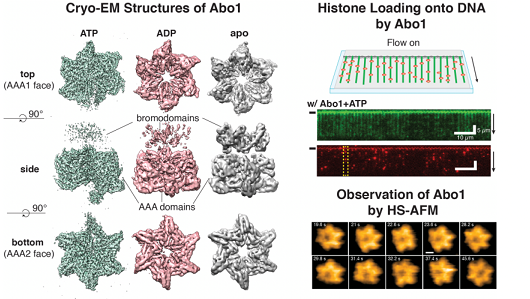Researchers at the Korea Advanced Institute of Science and Technology (KAIST), Ulsan National Institute of Science and Technology (UNIST), and The National Institutes of Natural Sciences (NINS), revealed the first molecular structure of the ATAD2 family of histone chaperones, a factor that is strongly correlated with the development of malignant tumors. This research was published online at Nature Communications on December 17, 2019.
Research Background
ATAD2 is a gene that is highly overexpressed in many human cancers such as prostate, lung, pancreatic, and colorectal cancer. Due to its clinical importance, many studies are investigating ATAD2 as a potential cancer drug target. Despite such attention to its therapeutic potential, the molecular structure of ATAD has been unknown.
Result
Now, taking advantage of recent advances in cryo-electron microscopy (cryo-EM), researchers have solved the full structure of the yeast counterpart of ATAD2 to atomic resolution. The structures show that ATAD2 undergoes ATP energy-dependent changes shifting between a ring and spiral shape. These changes were also observed by utilizing high-speed atomic force microscopy (HS-AFM).
The authors also find that ATAD2 binds histones and helps deposit them onto DNA, a process that is likely important in the chromatin assembly and the regulation of gene expression. This is the first example where it has been shown that a histone chaperone protein uses ATP energy to deliver histones.

Social significance of this research
“This study highlights how the advance and combination of biophysical tools can be used to further our understanding of disease, the lead author Carol Cho says. “This structure should provide new leads to developing anti-cancer drugs targeted towards ATAD2” says professor Song, the corresponding author.
Reference
Cho et al. (2019) “Structural basis of nucleosome assembly by the Abo1 AAA+ ATPase histone chaperone” Nature Communications
Main Authors
Ji-Joon Song (KAIST)
Carol Cho (KAIST)
Ja Yil Lee (UNIST)
Juwon Jang (KAIST)
Takayuki Uchihashi (NINS)
Hiroki Watanabe (NINS)
Koichi Kato (NINS)
Contact Person
Koichi Kato
Exploratory Research Center on Life and Living Systems (ExCELLS)/
Institute for Molecular Science, Natural Institutes of Natural Sciences
TEL: +81-564-59-5225
E-mail: kkato_at_excells.orion.ac.jp (Please replace the “_at_” with @)

